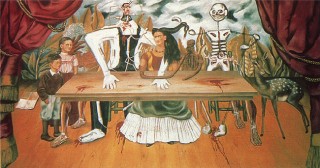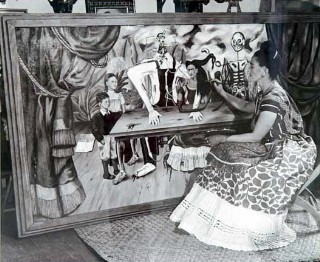The Wounded Table
1940
This is one of two large works that Kahlo painted, the other being "The Two Fridas". This painting measures approximately 4 feet by 8 feet. The extraordinary size may have been intentional as she knew it was going to be shown at the same exhibition where her "cheating husband" Diego was showing significantly smaller works.
Kahlo painted this work during her divorce from Diego Rivera, and her state of mind is reflected throughout this painting. The painting resembles a skewed version of "The Last Supper" with Frida playing the role of Christ at the center of the table. She is surrounded by an eclectic assortment of characters: Cristina's two children, a large papier-mâché Judas, a skeleton, a pre-Columbian sculpture and her pet fawn Granizo. The Judas, the skeleton and the pre-Columbian idol are three of the four characters in her earlier painting "The Four Inhabitants of Mexico City - 1938".
The oversized Judas
on Frida's right, dressed in blue overalls, represents Diego who betrayed
her when he had an affair with her younger sister Cristina. The figure
has his hands on the table as did the Judas that betrayed Christ. This
gesture may be symbolizing Luke's words at the Last Supper: "…but
behold the hand of him that betrayeth me is with me on the table (Luke,
22:21). Despite the betrayal, Frida allows the Juda (Diego) to protectively
place his arm around her.
To her left, the
skeleton is holding a strand of Frida's hair…perhaps she is flirting
with death. The pre-Columbian sculpture is intertwined with Kahlo, sharing
the same arm symbolizing her connection to her Mexican roots. The threatening
characters seem to be between the painter and the innocent figures of
the children and the fawn, making them unreachable. This painting contains
a lot of references to Frida's deformed leg and foot. The idol has peglegs,
the skeleton and the Judas both have bandaged and bloodied feet and the
table has flayed human legs. Perhaps she feels that her deformity in some
way contributed to her breakup with Diego. The idol has peglegs, the skeleton
and the Judas both have bandaged and bloodied feet and the table has flayed
human legs, all references to Frida's own deformed right leg and foot.
The two innocent children are the children of Frida's younger sister Cristina:
Antonio and Isolda.. They seem to be unaware of the situation or their
surroundings.
Frida worked on this painting right up to the last minute to finish it for showing at the January 17th opening of the "International Exhibition of Surrealism" at the Gallery of Mexican Art in Mexico City. In the 50's, there was an exhibition of Rivera and Kahlo works in Moscow. Two paintings by Rivera and Frida's "The Wounded Table" disappeared along with works by other artists. They were not with the rest of the collection when it arrived back in Mexico. In 1996 or 1997, art curator Christor Burrus claimed to have seen the three missing paintings in a storage warehouse that may belong to Moscow's Pushkin museum. Art historian Raquel Tibol learned of the discovery by Burrus and alerted the media and the government of Mexico. A representative of the Pushkin admitted having one of Rivera's paintings (Glorious Victory) since 1958 but did not comment on the other two. The director of Mexico's National Institute of Fine Arts contacted the Pushkin Museum requesting their return but got no response.
Contrary to the "stolen painting" theory, in a 1950 interview Kahlo stated that: "I gave it [The Wounded Table painting] to the museum in Moscow."

(Click Here to View Larger Image)
(Pinche aquí para ver la imagen aumentada)
Oil
on canvas
47.8" x 96.5"
Whereabouts Unknown
Óleo sobre lienzo
122 x 244 cm.
Paradero desconocido

Frida
Painting "The Wounded Table"
Photo by Bernard Silberstein
Frida
pintando "La mesa herida"
Foto por Bernard Silberstein
La mesa herida
1940
Esta es una de las
dos obras de tamaño mas grande que Frida pintó (la otra
es "Las dos Fridas")
Este cuadro mide aproximadamente 4 pies x 8 pies (122 x 244 cms.). Las
grandes medidas del cuadro podrían haber sido intencionales ya
que ella sabía que iba a ser exhibido en la misma exposición
donde su "marido infiel", Diego, estaba mostrando trabajos mucho
más pequeños.
Kahlo pinto este
retrato durante su divorcio de Diego Rivera y su estado mental se refleja
en todos los aspectos de esta pintura. La pintura parece una parodia de
"La última cena", con Frida haciendo el papel
de Cristo en el centro de la mesa. Está rodeada por un grupo ecléctico
de personajes: los dos hijos de Cristina, un enorme Judas de papier-mache,
un esqueleto, una escultura pre-colombina y su mascota, el venado Granizo.
El Judas, el esqueleto y el ídolo pre-columbino son tres de los
cuatro caracteres que aparecen en su previa obra "Los
cuatro habitantes de la Ciudad de México, 1938".
El enorme Judas que está a la derecha de Frida, vestido con un
peto azul representa a Diego, el cual la traicionó cuando tuvo
un asunto amoroso con la hermana menor de Frida, Cristina. La figura tiene
sus manos en la mesa, como el Judas que traicionó a Cristo. Este
gesto puede simbolizar las palabras de San Lucas durante la Ultima Cena…
"Más he aquí, la mano del que me entrega está
conmigo en la mesa" (Lucas, 22:21). A pesar de la traición,
Frida permite al Judas (Diego) que pase su brazo protector alrededor de
su cuerpo.
A su izquierda, el
esqueleto sostiene un mechón de pelo de Frida…quizás
la pintora está coqueteando con la muerte. La escultura pre-colombina
está interconectada con Kahlo, compartiendo el mismo brazo que
simboliza su conexión a sus raíces Mexicanas. Los caracteres
amenazantes parecen hallarse entre la pintora y las inocentes figuras
de los niños y el venado, haciéndolos inalcanzables. Esta
pintura contiene un montón de referencias a los deformes pie y
pierna de Frida. El ídolo tiene patas de palo, el esqueleto y el
Judas ambos tienen los pies vendados y ensangrentados, y la mesa tiene
piernas humanas desolladas. Quizás Frida sentía que su deformidad,
de alguna manera, fue parte de la causa de su ruptura con Diego. Los dos
inocentes niños son los hijos de la hermana menor de Frida Cristina:
Antonio e Isolda. Parecen no ser conscientes de la situación que
los rodea.
Frida trabajó en este cuadro hasta el ultimo minuto, a fin de tenerlo
listo para mostrarlo en la inauguración del 17 de Enero de la "Exhibición
Internacional del Surrealismo" en la Galeria de Arte Mexicano
en la ciudad de México. En los años 50, se celebró
una muestra de los trabajos de Kahlo y Rivera en Moscú. Dos cuadros
de Rivera, así como "La Mesa herida" desaparecieron,
junto con trabajos de otros artistas. No estaban con el resto de la colección
cuando fue devuelta a México. En 1996 o 1997, el curador Christor
Burrus dijo que había visto los tres cuadros perdidos en un almacén
que podría pertenecer al Museo Pushkin de Moscú. La historiadora
de arte Raquel Tibol se enteró del descubrimiento de Burrus y avisó
a los medios de comunicación y al gobierno de México. Un
representante del Museo Pushkin admitió el tener una de las obras
de Rivera ("Victoria gloriosa") desde 1958 pero no hizo
comentarios acerca de las otras dos. El director del Instituto Nacional
de Bellas Artes de México contactó al Museo Pushkin solicitando
la devolución, pero no obtuvieron respuesta.
Contrariamente a la teoría del "cuadro robado", en una entrevista de 1950 Kahlo dijo que "Lo he dado [el cuadro "La mesa herida"] al museo en Moscú" (nota del traductor: esta frase ha sido traducida de la version traducida al ingles del libro,ignoro las palabras exactas de Frida Kahlo)